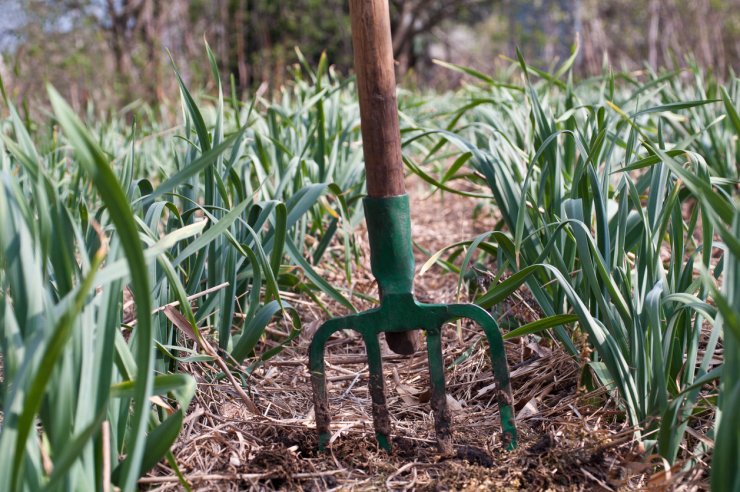
Growing garlic in a garden bed.
Garlic is grown from seed cloves, which are cloves from bulbs of garlic that have been left in the ground a little longer than the garlic bulbs that are intended for food. Usually seed cloves are chosen from the largest cloves on a bulb. Generally, the larger the clove you plant, the larger the bulb will be. We recommend keeping the peel on the cloves to help protect them as they grow. Be sure to remove the cloves from the bulb the same day you plant them.
Where to Plant
Choose an area that gets at least six hours of sun per day, with soil that is loamy and well-drained. Garlic needs consistent moisture, but it shouldn’t be soggy. If your soil is particularly heavy or clay-like, consider adding some perlite to increase aeration and drainage. In general, you should water the garlic whenever the soil feels dry. And if you live in a hot climate, you may need to water daily so the soil doesn’t get too dry.
When to Plant
Garlic is best planted in the late fall, before the first frost, because it benefits from overwintering. The roots develop in the fall and winter, and garlic bulbs can be harvested in mid-summer.
Plant Spacing
To ensure optimal growth, garlic cloves require 6 inches of separation between them when planted. We grant an additional 2-inch buffer due to the competitive nature of plants above and below ground. In this way, we are providing plenty of space for each clove to thrive without creating unnecessary competition in our garden beds.
In southern regions, plant cloves at a depth of about 2 inches deep. In northern regions, plant cloves about 4 inches deep. Garlic is a hardy plant, but planting cloves a bit deeper protects them from harsh northern winters.
How to Plant
Always plant seed cloves pointy side up. If you plant the cloves pointy side down, the stem will still find its way to the sun, but your bulb will be misshapen. It will still be edible, of course, just not as pretty.
Companion Planting
Did you know that garlic is a natural insect repellent? Some gardeners plant it around the borders of their vegetable gardens to ward off pests. You can also plant garlic in rows between compatible plants, which include lettuce, beets, broccoli, cabbage, kale, and tomatoes.
However, avoid planting garlic with beans, peas, asparagus, sage, or parsley; garlic can actually stunt the growth of these plants.
Garlic doesn’t like to compete with weeds, so weed your garlic bed regularly to make room for the bulbs to grow.

Mulched rows of garlic.
Mulching Your Garlic Bed
Mulch is recommended for garlic plants. Choose compost or chopped leaves for mulching your garlic bed and lay down about 4 inches. Straw also works for mulching garlic, but avoid it if you live in a damp region, as it can mold.
Mulching will keep weeds down and protect plants against cold winters. It also helps prevent garlic roots from being heaved out of the soil as it freezes and thaws during the winter and spring.
Remove the mulch in the spring, after the last danger of frost.
Start Growing Garlic!
Garlic is easier to grow than you might think. In fact, home gardeners have grown garlic in every state in the United States, including Alaska and Hawaii! Hence, there are varieties of garlic suited for every climate. Hardneck varieties prefer long, cold winters, so are better for northern climates, while softneck varieties are great for hotter areas.
As long as you have some basic gardening know-how, you can grow and harvest a crop of garlic to use in your kitchen and for home remedies.
Please tell us about your garlic garden. Do you have any tips for weeding or mulching? Please comment below and share your ideas.


 Previous
Previous


This Fall I plan to give garlic another chance to grow as previously either the garlic never grew or grew too high. Let me explain, I planted garlic in early Fall and used straw from Halloween hobby store to cover plants. Much to my surprise the plants grew to over 5 ft high, when I took pictures to my local nursery to ask what happened we had a good laugh, I was growing hay not garlic. ???? Lynda
Article is incomplete. What about fertilizing for maximum yield?
I put the cloves in a cup with about 1/4″ water, first. In about 1 week the roots and scapes start . I wait for about 3 weeks then plant the rooted bulbs. Soon there are many scapes to cut and add to salads or stir-fry.
I have my garden on a slope hill and use cinder blocks to level the hill into multiple planting areas. I plant the Garlic in the holes of the cinder blocks. Works great! Also helps keep the deer and small critters out of the garden. The garlic is literally a full 360 degrees around and in the middle of the garden. Also having them in the cinder blocks keeps them isolated from other plants. Never have any conflict in planting.
Hi Dennis,
Love that! What a great idea, thank you for sharing.
Norann